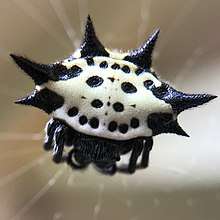Orb-weaver spider
Orb-weaver spiders or araneids are members of the spider family Araneidae. They are the most common group of builders of spiral wheel-shaped webs often found in gardens, fields and forest. "Orb" can in English mean "circular",[1] hence the English name of the group. Araneids have eight similar eyes, hairy or spiny legs, and no stridulating organs.
| Orb-weaver spiders | |
|---|---|
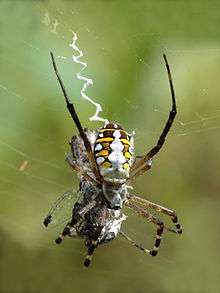 | |
| Argiope catenulata | |
| Scientific classification | |
| Kingdom: | Animalia |
| Phylum: | Arthropoda |
| Subphylum: | Chelicerata |
| Class: | Arachnida |
| Order: | Araneae |
| Infraorder: | Araneomorphae |
| Superfamily: | Araneoidea |
| Family: | Araneidae Clerck, 1757 |
| Diversity | |
| 175 genera, 4202 species | |
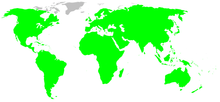 | |
The family is cosmopolitan, including many well-known large or brightly colored garden spiders. With 3122 species in 172 genera worldwide, Araneidae is the third-largest family of spiders (behind Salticidae and Linyphiidae).[2] Araneid webs are constructed in a stereotyped fashion. A framework of nonsticky silk is built up before the spider adds a final spiral of silk covered in sticky droplets.
Orb-webs are also produced by members of other spider families. The long-jawed orb weavers (Tetragnathidae) were formerly included in the Araneidae; they are closely related, being part of the superfamily Araneoidea. The family Arkyidae has been split off from the Araneidae.[3][2] The cribellate or hackled orb-weavers (Uloboridae) belong to a different group of spiders. Their webs are strikingly similar, but use a different kind of sticky silk.
Description
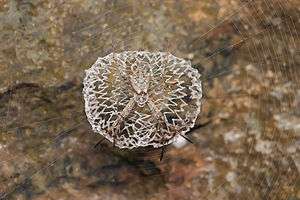
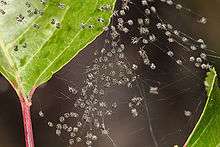
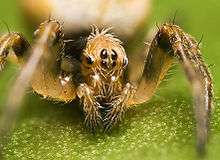
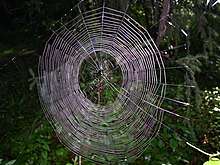
Generally, orb-weaving spiders are three-clawed builders of flat webs with sticky spiral capture silk. The building of a web is an engineering feat, begun when the spider floats a line on the wind to another surface. The spider secures the line and then drops another line from the center, making a "Y". The rest of the scaffolding follows with many radii of nonsticky silk being constructed before a final spiral of sticky capture silk.
The third claw is used to walk on the nonsticky part of the web. Characteristically, the prey insect that blunders into the sticky lines is stunned by a quick bite, and then wrapped in silk. If the prey is a venomous insect, such as a wasp, wrapping may precede biting and/or stinging. The webs of a few species are strong enough to capture small vertebrates, including bats and birds.[4]
Many orb-weavers build a new web each day. Most orb-weavers tend to be active during the evening hours; they hide for most of the day. Generally, towards evening, the spider will consume the old web, rest for approximately an hour, then spin a new web in the same general location. Thus, the webs of orb-weavers are generally free of the accumulation of detritus common to other species, such as black widow spiders.
Some orb-weavers do not build webs at all. Members of the genera Mastophora in the Americas, Cladomelea in Africa, and Ordgarius in Australia produce sticky globules, which contain a pheromone analog. The globule is hung from a silken thread dangled by the spider from its front legs. The pheromone analog attracts male moths of only a few species. These get stuck on the globule and are reeled in to be eaten. Both types of bolas spiders are highly camouflaged and difficult to locate.
The spiny orb-weaving spiders in the genera Gasteracantha and Micrathena look like plant seeds or thorns hanging in their orb-webs. Some species of Gasteracantha have very long, horn-like spines protruding from their abdomens.
One feature of the webs of some orb-weavers is the stabilimentum, a crisscross band of silk through the center of the web. It is found in several genera, but Argiope – the yellow and banded garden spiders of North America – is a prime example. As orb-weavers age, they tend to have less production of their silk, many adult orb-weavers can then depend on their coloration to attract more of their prey.[5] The band may be a lure for prey, a marker to warn birds away from the web, and a camouflage for the spider when it sits in the web. The stabilimentum may decrease the visibility of the silk to insects, thus making it harder for prey to avoid the web.[6] The orb-web consists of a frame and supporting radii overlaid with a sticky capture spiral, and the silks used by orb-weaver spiders have exceptional mechanical properties to withstand the impact of flying prey.[7]
During the Cretaceous, a radiation of angiosperm plants and their insect pollinators occurred. Fossil evidence shows that the orb web was in existence at this time, which permitted a concurrent radiation of the spider predators along with their insect prey.[8][9] The capacity of orb–webs to absorb the impact of flying prey led orbicularian spiders to become the dominant predators of aerial insects in many ecosystems.[10] Insects and spiders have comparable rates of diversification, suggesting they co-radiated, and the peak of this radiation occurred 100 Mya before the origin of angiosperms.[11] Vollrath and Selden (2007) make the bold proposition that insect evolution was driven less by flowering plants than by spider predation – particularly through orb webs – as a major selective force.
Most arachnid webs are vertical and the spiders usually hang with their head downward. A few webs, such as those of orb-weavers in the genus Metepeira have the orb hidden within a tangled space of web. Some Metepiera are semisocial and live in communal webs. In Mexico, such communal webs have been cut out of trees or bushes and used for living fly paper. In 2009, workers at a Baltimore Wastewater Treatment Plant called for help to deal with over 100 million orb-weaver spiders, living in a community that managed to spin a phenomenal web that covered some 4 acres of a building with spider densities in some areas reaching 35,176 spiders per cubic meter.[12]
Taxonomy
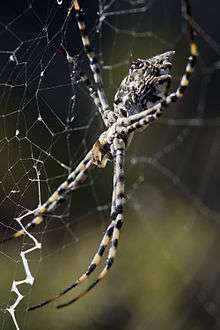
The oldest known true orb-weaver is Mesozygiella dunlopi, from the Lower Cretaceous. Several fossils provide direct evidence that the three major orb-weaving families, namely Araneidae, Tetragnathidae and Uloboridae, had evolved by this time, about 140 million years ago.[13] They probably originated during the Jurassic (200 to 140 million years ago). Based on new molecular evidence in silk genes, all three families are likely to have a common origin.[7][9][10]
The two families, Deinopoidea and Araneoidea, have similar behavioral sequences and spinning apparatuses to produce architecturally similar webs. The Araneidae weave true viscid silk with an aqueous glue property, and the Deinopoidea use dry fibrils and sticky silk.[7][14] The Deinopoidea (including the Uloboridae), have a cribellum – a flat, complex spinning plate from which the cribellate silk is released.[15]
They also have a calamistrum – an apparatus of bristles used to comb the cribellate silk from the cribellum. The Araneoidea, or the "ecribellate" spiders, do not have these two structures. The two families of orb-weaving spiders are morphologically very distinct, yet there is much similarity between their web form and web construction behavior. The cribellates retained the ancestral character, yet the cribellum was lost in the escribellates. The lack of a functional cribellum in araneoids is most likely synapomorphic.[15]
If the orb-weaver spiders are a monophyletic group, the fact that only some species in the group lost a feature adds to the controversy. The cribellates are split off as a separate taxon that retained the primitive feature, which makes the lineage paraphyletic and not synonymous with any real evolutionary lineage. The morphological and behavioral evidence surrounding orb webs led to the disagreement over a single origin or a dual origin.[15] While early molecular analysis provided more support for a monophyletic origin,[7][9][10] other evidence indicates that orb-weavers evolved earlier phylogenetically than previously thought, and were extinct at least three times during the Cretaceous.[16][17]
Reproduction
Araneid species either mate at the central hub of the web, where the male slowly traverses the web, trying not to get eaten, and when reaching the hub, mounts the female; or the male constructs a mating thread inside or outside the web to attract the female via vibratory courtship, and if successful, mating occurs on the thread.[18]
In the cannibalistic and polyandrous orb-web spider Argiope bruennichi, the much smaller males are attacked during their first copulation and are cannibalized in up to 80% of the cases.[19] All surviving males die after their second copulation, a pattern observed on other Argiope species. Whether a male survives his first copulation depends on the duration of the genital contact: males that jump off early (before 5 seconds) have a chance of surviving, while males that copulate longer (greater than 10 seconds) invariably die. Prolonged copulation, although associated with cannibalism, enhances sperm transfer and relative paternity.[19]
It was observed that when males mated with a non-sibling female, the duration of their copulation was prolonged, and consequently the males were cannibalized more frequently.[20] When males mated with a sibling female, they copulated briefly, and thus were more likely to escape cannibalism. By escaping, their chance of mating again with a non-kin female likely would be increased. These observations suggest that males can adaptively adjust their investment based on the degree of genetic relatedness of the female in order to avoid inbreeding depression.
Sexual size dimorphism
Sexual dimorphism refers to physical differences between males and females of the same species. One such difference can be in size.
Araneids often exhibit size dimorphism typically known as extreme sexual size dimorphism, due to the extent of differences in size. The size difference among species of Araneidae ranges greatly. Some females, such as those of the Nephila pilipes, can be at least 9 times larger than the male, while others are only slightly larger than the male.[21] The larger size female is typically thought to be selected through fecundity selection,[22] the idea that bigger females can produce more eggs, thus more offspring. Although a great deal of evidence points towards the greatest selection pressure on larger female size, there is some evidence that selection can favor small male size as well.
Araneids also exhibit a phenomenon called sexual cannibalism, which is commonly found throughout Araneidae.[18] Evidence suggests a negative correlation between sexual size dimorphism and incidences of sexual cannibalism.[22] Other evidence, however, has shown that differences in cannibalistic events among araneids when having smaller or slightly larger males is advantageous.[18]
Some evidence has shown that extreme dimorphism may be the result of males avoiding detection by the females. For males of these species, being smaller in size may be advantageous in moving the central hub of a web so female spiders may be less likely to detect the male, or even if detected as prey to be eaten, the small size may indicate little nutritional value. Larger-bodied male araneids may be advantageous when mating on a mating thread because the thread is constructed from the edge of the web orb to structural threads or to nearby vegetation.[18] Here larger males may be less likely to be cannibalized, as the males are able to copulate while the female is hanging, which may make them safer from cannibalism.[18] In one subfamily of Araneid that uses a mating thread, Gasteracanthinae, sexual cannibalism is apparently absent despite extreme size dimorphism.[23]
Genera
As of April 2019, the World Spider Catalog accepts the following genera:[24]
- Acacesia Simon, 1895 — South America, North America
- Acantharachne Tullgren, 1910 — Congo, Madagascar, Cameroon
- Acanthepeira Marx, 1883 — North America, Brazil, Cuba
- Acroaspis Karsch, 1878 — New Zealand, Australia
- Acrosomoides Simon, 1887 — Madagascar, Cameroon, Congo
- Actinacantha Simon, 1864 — Indonesia
- Actinosoma Holmberg, 1883 — Colombia, Argentina
- Aculepeira Chamberlin & Ivie, 1942 — North America, Central America, South America, Asia, Europe
- Acusilas Simon, 1895 — Asia
- Aethriscus Pocock, 1902 — Congo
- Aethrodiscus Strand, 1913 — Central Africa
- Aetrocantha Karsch, 1879 —
- Afracantha Dahl, 1914 —
- Agalenatea Archer, 1951 — Ethiopia, Asia
- Alenatea Song & Zhu, 1999 — Asia
- Allocyclosa Levi, 1999 — United States, Panama, Cuba
- Alpaida O. Pickard-Cambridge, 1889 — Central America, South America, Mexico, Caribbean
- Amazonepeira Levi, 1989 — South America
- Anepsion Strand, 1929 — Oceania, Asia
- Arachnura Vinson, 1863 — Asia, Oceania, Africa
- Araneus Clerck, 1757 — Africa, South America, North America, Oceania, Asia, Central America, Europe, Cuba
- Araniella Chamberlin & Ivie, 1942 — Asia
- Aranoethra Butler, 1873 —
- Argiope Audouin, 1826 — Asia, Oceania, Africa, North America, South America, Costa Rica, Cuba, Portugal
- Artifex Kallal & Hormiga, 2018 — Australia
- Artonis Simon, 1895 — Myanmar, Ethiopia
- Aspidolasius Simon, 1887 — South America
- Augusta O. Pickard-Cambridge, 1877 — Madagascar
- Austracantha Dahl, 1914 — Australia
- Backobourkia Framenau, Dupérré, Blackledge & Vink, 2010 — Australia, New Zealand
- Bertrana Keyserling, 1884 — South America, Central America
- Caerostris Thorell, 1868 — Africa, Asia
- Carepalxis L. Koch, 1872 — Oceania, South America, Mexico, Jamaica
- Celaenia Thorell, 1868 — Australia, New Zealand
- Cercidia Thorell, 1869 — Russia, Kazakhstan, India
- Chorizopes O. Pickard-Cambridge, 1871 — Asia, Madagascar
- Chorizopesoides Mi & Wang, 2018 — China, Vietnam
- Cladomelea Simon, 1895 — South Africa, Congo
- Clitaetra Simon, 1889 — Africa, Sri Lanka
- Cnodalia Thorell, 1890 — Indonesia, Japan
- Coelossia Simon, 1895 — Sierra Leone, Mauritius, Madagascar
- Colaranea Court & Forster, 1988 — New Zealand
- Collina Urquhart, 1891 — Australia
- Colphepeira Archer, 1941 — United States, Mexico
- Cryptaranea Court & Forster, 1988 — New Zealand
- Cyclosa Menge, 1866 — Caribbean, Asia, Oceania, South America, North America, Central America, Africa, Europe
- Cyphalonotus Simon, 1895 — Asia, Africa
- Cyrtarachne Thorell, 1868 — Asia, Africa, Oceania
- Cyrtobill Framenau & Scharff, 2009 — Australia
- Cyrtophora Simon, 1864 — Asia, Oceania, Dominican Republic, Costa Rica, South America, Africa
- Deione Thorell, 1898 — Myanmar
- Deliochus Simon, 1894 — Australia, Papua New Guinea
- Dolophones Walckenaer, 1837 — Australia, Indonesia
- Dubiepeira Levi, 1991 — South America
- Edricus O. Pickard-Cambridge, 1890 — Mexico, Panama, Ecuador
- Enacrosoma Mello-Leitão, 1932 — South America, Central America, Mexico
- Encyosaccus Simon, 1895 — South America
- Epeiroides Keyserling, 1885 — Costa Rica, Brazil
- Eriophora Simon, 1864 — Oceania, United States, South America, Central America, Africa
- Eriovixia Archer, 1951 — Asia, Papua New Guinea, Africa
- Eustacesia Caporiacco, 1954 — French Guiana
- Eustala Simon, 1895 — South America, North America, Central America, Caribbean
- Exechocentrus Simon, 1889 — Madagascar
- Faradja Grasshoff, 1970 — Congo
- Friula O. Pickard-Cambridge, 1897 — Indonesia
- Galaporella Levi, 2009 — Ecuador
- Gasteracantha Sundevall, 1833 — Oceania, Asia, United States, Africa, Chile
- Gastroxya Benoit, 1962 — Africa
- Gea C. L. Koch, 1843 — Africa, Oceania, Asia, United States, Argentina
- Gibbaranea Archer, 1951 — Asia, Europe, Algeria
- Glyptogona Simon, 1884 — Sri Lanka, Italy, Israel
- Gnolus Simon, 1879 — Chile, Argentina
- Herennia Thorell, 1877 — Asia, Oceania
- Heterognatha Nicolet, 1849 — Chile
- Heurodes Keyserling, 1886 — Asia, Australia
- Hingstepeira Levi, 1995 — South America
- Hypognatha Guérin, 1839 — South America, Central America, Mexico, Trinidad
- Hypsacantha Dahl, 1914 —
- Hypsosinga Ausserer, 1871 — Asia, North America, Greenland, Africa
- Ideocaira Simon, 1903 — South Africa
- Isoxya Simon, 1885 — Africa, Yemen
- Kaira O. Pickard-Cambridge, 1889 — North America, South America, Cuba, Guatemala
- Kapogea Levi, 1997 — Mexico, South America, Central America
- Kilima Grasshoff, 1970 — Congo, Seychelles, Yemen
- Larinia Simon, 1874 — Asia, Africa, South America, Europe, Oceania, North America
- Lariniaria Grasshoff, 1970 — Asia
- Larinioides Caporiacco, 1934 — Asia
- Lariniophora Framenau, 2011 — Australia
- Leviellus Wunderlich, 2004 — Asia, France
- Lewisepeira Levi, 1993 — Panama, Mexico, Jamaica
- Lipocrea Thorell, 1878 — Asia, Europe
- Macracantha Simon, 1864 — India, China, Indonesia
- Madacantha Emerit, 1970 — Madagascar
- Mahembea Grasshoff, 1970 —
- Mangora O. Pickard-Cambridge, 1889 — Asia, North America, South America, Central America, Caribbean
- Manogea Levi, 1997 — South America, Central America, Mexico
- Mastophora Holmberg, 1876 — South America, North America, Central America, Cuba
- Mecynogea Simon, 1903 — North America, South America, Cuba
- Megaraneus Lawrence, 1968 — Africa
- Melychiopharis Simon, 1895 — Brazil
- Metazygia F. O. Pickard-Cambridge, 1904 — South America, Central America, North America, Caribbean
- Metepeira F. O. Pickard-Cambridge, 1903 — North America, Caribbean, South America, Central America
- Micrathena Sundevall, 1833 — South America, Caribbean, Central America, North America
- Micrepeira Schenkel, 1953 — South America, Costa Rica
- Micropoltys Kulczyński, 1911 — Papua New Guinea, Australia
- Milonia Thorell, 1890 — Singapore, Indonesia, Myanmar
- Molinaranea Mello-Leitão, 1940 — Chile, Argentina
- Nemoscolus Simon, 1895 — Africa
- Nemosinga Caporiacco, 1947 — Tanzania
- Nemospiza Simon, 1903 — South Africa
- Neogea Levi, 1983 — Papua New Guinea, India, Indonesia
- Neoscona Simon, 1864 — Asia, Africa, Europe, Oceania, North America, Cuba, South America
- Nephila Leach, 1815 — Asia, Oceania, United States, Africa, South America
- Nephilengys L. Koch, 1872 — Asia, Oceania
- Nephilingis Kuntner, 2013 — South America, Africa
- Nicolepeira Levi, 2001 — Chile
- Novakiella Court & Forster, 1993 — Australia, New Zealand
- Novaranea Court & Forster, 1988 — Australia, New Zealand
- Nuctenea Simon, 1864 — Algeria, Asia
- Oarces Simon, 1879 — Brazil, Chile, Argentina
- Ocrepeira Marx, 1883 — South America, Central America, Caribbean, North America
- Ordgarius Keyserling, 1886 — Asia, Oceania
- Paralarinia Grasshoff, 1970 — Congo, South Africa
- Paraplectana Brito Capello, 1867 — Asia, Africa
- Paraplectanoides Keyserling, 1886 — Australia
- Pararaneus Caporiacco, 1940 — Madagascar
- Parawixia F. O. Pickard-Cambridge, 1904 — Mexico, South America, Asia, Papua New Guinea, Central America, Trinidad
- Parmatergus Emerit, 1994 — Madagascar
- Pasilobus Simon, 1895 — Africa, Asia
- Perilla Thorell, 1895 — Myanmar, Vietnam, Malaysia
- Pherenice Thorell, 1899 — Cameroon
- Phonognatha Simon, 1894 — Australia
- Pitharatus Simon, 1895 — Malaysia, Indonesia
- Plebs Joseph & Framenau, 2012 — Oceania, Asia
- Poecilarcys Simon, 1895 — Tunisia
- Poecilopachys Simon, 1895 — Oceania
- Poltys C. L. Koch, 1843 — Asia, Africa, Oceania
- Porcataraneus Mi & Peng, 2011 — India, China
- Pozonia Schenkel, 1953 — Caribbean, Paraguay, Mexico, Panama
- Prasonica Simon, 1895 — Africa, Asia, Oceania
- Prasonicella Grasshoff, 1971 — Madagascar, Seychelles
- Pronoides Schenkel, 1936 — Asia
- Pronous Keyserling, 1881 — Malaysia, Mexico, Central America, South America, Madagascar
- Pseudartonis Simon, 1903 — Africa
- Pseudopsyllo Strand, 1916 — Cameroon
- Psyllo Thorell, 1899 — Cameroon, Congo
- Pycnacantha Blackwall, 1865 — Africa
- Rubrepeira Levi, 1992 — Mexico, Brazil
- Scoloderus Simon, 1887 — Belize, North America, Argentina, Caribbean
- Sedasta Simon, 1894 — West Africa
- Singa C. L. Koch, 1836 — Africa, Asia, North America, Europe
- Singafrotypa Benoit, 1962 — Africa
- Siwa Grasshoff, 1970 — Asia
- Spilasma Simon, 1897 — South America, Honduras
- Spinepeira Levi, 1995 — Peru
- Spintharidius Simon, 1893 — South America, Cuba
- Taczanowskia Keyserling, 1879 — Mexico, South America
- Talthybia Thorell, 1898 — China, Myanmar
- Tatepeira Levi, 1995 — South America, Honduras
- Telaprocera Harmer & Framenau, 2008 — Australia
- Testudinaria Taczanowski, 1879 — South America, Panama
- Thelacantha Hasselt, 1882 — Madagascar, Asia, Australia
- Thorellina Berg, 1899 — Myanmar, Papua New Guinea
- Togacantha Dahl, 1914 —
- Umbonata Grasshoff, 1971 — Tanzania
- Ursa Simon, 1895 — Asia, South America, South Africa
- Verrucosa McCook, 1888 — North America, Panama, South America, Australia
- Wagneriana F. O. Pickard-Cambridge, 1904 — South America, Central America, Caribbean, North America
- Witica O. Pickard-Cambridge, 1895 — Cuba, Mexico, Peru
- Wixia O. Pickard-Cambridge, 1882 — Brazil, Guyana, Bolivia
- Xylethrus Simon, 1895 — South America, Mexico, Jamaica, Panama
- Yaginumia Archer, 1960 — Asia
- Zealaranea Court & Forster, 1988 — New Zealand
- Zilla C. L. Koch, 1834 — Azerbaijan, India, China
- Zygiella F. O. Pickard-Cambridge, 1902 — North America, Asia, Ukraine, South America
See also
References
- "orb". Merriam-Webster Dictionary. Retrieved 5 December 2015.
- "Currently valid spider genera and species". World Spider Catalog. Natural History Museum, Bern. Retrieved 16 August 2017.
- Dimitrov, Dimitar; Benavides, Ligia R.; Arnedo, Miquel A.; Giribet, Gonzalo; Griswold, Charles E.; Scharff, Nikolaj & Hormiga, Gustavo (2016). "Rounding up the usual suspects: a standard target-gene approach for resolving the interfamilial phylogenetic relationships of ecribellate orb-weaving spiders with a new family-rank classification (Araneae, Araneoidea)" (PDF). Cladistics. 33 (3): 221–250. doi:10.1111/cla.12165. Retrieved 2016-10-18.
- Valdez, Jose W. (27 July 2020). "Arthropods as vertebrate predators: A review of global patterns". Global Ecology and Biogeography. doi:10.1111/geb.13157. ISSN 1466-8238.
- Gálvez, Dumas; Añino, Yostin; De la O, Jorge M. (26 February 2018). "Age variation in the body coloration of the orb-weaver spider Alpaida tuonabo and its implications on foraging". Scientific Reports. 8 (1): 3599. doi:10.1038/s41598-018-21971-0. ISSN 2045-2322. PMC 5827658. PMID 29483535.
- Blackledge, Todd A. & Wenzel, John W. (2000). "The evolution of cryptic spider silk: a behavioral test". Behavioral Ecology. 11 (2): 142–145. doi:10.1093/beheco/11.2.142.
- Garb, Jessica E.; DiMauro, Teresa; Vo, Victoria & Hayashi, Cheryl Y. (2006). "Silk genes support the single origin of orb webs". Science. 312 (5781): 1762. CiteSeerX 10.1.1.623.4339. doi:10.1126/science.1127946. PMID 16794073.
- "Detangling History". Smithsonian: 24. September 2006. "Two pieces of Spanish amber contain the oldest known spider web and orb–weaving spider; both specimens are at least 110 million years old. The new findings, along with an analysis of the proteins in spider silk, indicate that orb–weaving spiders date as far back as 144 million years."
- Penney, David & Ortuño, Vicente M. (2006). "Oldest true orb-weaving spider (Araneae: Araneidae)". Biology Letters. 2 (3): 447–450. doi:10.1098/rsbl.2006.0506. PMC 1686203. PMID 17148427.
- Blackledge, Todd A.; Scharff, Nikolaj; Coddington, Jonathan A.; Szüts, Tamas; Wenzel, John W.; Hayashi, Cheryl Y. & Agnarsson, Ingi (2009). "Reconstructing web evolution and spider diversification in the molecular era". Proceedings of the National Academy of Sciences. 106 (13): 5229–5234. doi:10.1073/pnas.0901377106. PMC 2656561. PMID 19289848.
- Vollrath, Fritz & Selden, Paul (2007). "The role of behavior in the evolution of spiders, silks, and webs". Annual Review of Ecology, Evolution, and Systematics. 38: 819–846. doi:10.1146/annurev.ecolsys.37.091305.110221.
- Alford, Justine (2 November 2014). "Orb-Weaver Spiders Stuff A Treatment Plant With A 4-Acre Web". IFLScience. Retrieved 6 April 2015.
- Peñalver, Enrique; Grimaldi, David A. & Delclòs, Xavier (2006). "Early Cretaceous spider web with its prey". Science. 312 (5781): 1761. doi:10.1126/science.1126628. PMID 16794072.
- Shear, William A. (1986). "The evolution of web-building behavior in spiders: a third generation of hypotheses". In Shear, William A. (ed.). Spiders: webs, behavior, and evolution. Stanford CA: Stanford University Press. pp. 364–400. ISBN 978-0-8047-1203-3.
- Coddington, Jonathan A. (1986). "The monophyletic origin of the orb web". In Shear, William A. (ed.). Spiders: webs, behavior, and evolution. Stanford CA: Stanford University Press. pp. 319–363. ISBN 978-0-8047-1203-3.
- Fernández, R; Kallal, R.J.; Dimitrov, D (2018). "Phylogenomics, diversification dynamics, and comparative transcriptomics across the spider tree of life". Current Biology. 28 (9): 1489–1497.e5. doi:10.1016/j.cub.2018.03.064. PMID 29706520.
- Garrison, N; Rodriguez, L. J.; Agnarsson, I; Coddington, J.A.; Griswold, C.E; Hamilton, C.A; Hedin, M. (2016). "Spider phylogenomics: untangling the spider tree of life". PeerJ. 4: e1719. doi:10.7717/peerj.1719. PMC 4768681. PMID 26925338.
- Elgar, Mark (1991). "Sexual Cannibalism, Size Dimorphism, and Courtship Behavior in Orb-Weaving Spiders (Araneidae)". Evolution. 45 (2): 444–448. doi:10.2307/2409679. JSTOR 2409679. PMID 28567867.
- Schneider, J.M.; Gilberg, S.; Fromhage, L. & Uhl, G. (2006). "Sexual conflict over copulation duration in a cannibalistic spider". Animal Behaviour. 71 (4): 781–788. doi:10.1016/j.anbehav.2005.05.012.
- Welke, K.W. & Schneider, J.M. (2010). "Males of the orb-web spider Argiope bruennichi sacrifice themselves to unrelated females". Biol. Lett. 6 (5): 585–588. doi:10.1098/rsbl.2010.0214. PMC 2936157. PMID 20410027.
- Gustavo, H.; Scharff, N. & Coddington, J. (2000). "The Phylogenetic Basis of Sexual Size Dimorphism in Orb-Weaving Spiders (Araneae, Orbiculariae)". Systematic Biology. 49 (3): 435–462. doi:10.1080/10635159950127330. PMID 12116421.
- Legrand, R.S.; Morse, D.H. (2000). "Factors driving extreme sexual size dimorphism of a sit-and-wait predator under low density". Biological Journal of the Linnean Society. 71 (4): 643–664. doi:10.1111/j.1095-8312.2000.tb01283.x.
- Elgar, M. A. (1990). "Sexual dimorphism in leg-length among orb-weaving spiders: a possible role for sexual cannibalism". Journal of Zoology (London). 220 (3): 455–470. doi:10.1111/j.1469-7998.1990.tb04044.x.
- "Family: Araneidae Clerck, 1757". World Spider Catalog. Natural History Museum Bern. Retrieved 2019-04-22.
Further reading
- Crompton, John (1950). The Life of the Spider. New York: Mentor. OCLC 610423670.
- Dondale, C. D.; Redner, J. H.; Paquin, P.; Levi, H. W. (2003). The Orb-Weaving Spiders of Canada and Alaska. Araneae: Uloboridae, Tetragnathidae, Araneidae, Theridiosomatidae. Insects and Arachnids of Canada. 23. Ottawa: NRC Research Press. ISBN 978-0-660-18898-0.
- Kaston, B. J. (1953). How to Know the Spiders. Pictured key nature series (1st ed.). Dubuque, IA: W. C. Brown Co. OCLC 681432632.
- Levi, H. W. (1993). "The new orb-weaver genus Lewisepeira (Araneae: Araneidae)" (PDF). Psyche. 100 (3–4): 127–136. doi:10.1155/1993/97657. Archived from the original (PDF) on 2006-09-28. Retrieved 2006-07-15.
- Main, Barbara York (1976). Spiders. Australian Naturalist Library (2nd ed.). Sydney: Collins. OCLC 849736139.
- Foelix, Rainer F. (1996). Biology of Spiders (2nd ed.). New York: Oxford University Press. OCLC 300192823.
External links
| Wikimedia Commons has media related to Araneidae. |
| Wikispecies has information related to Araneidae |
- Spiders of Australia
- Spiders of northwestern Europe
- Araneae, Arachnology Home Pages
- World Spider Catalog
- Orb weavers of Kentucky, University of Kentucky
- Pictures of Mangora species
- Gasteracantha cancriformis, spinybacked orbweaver on the University of Florida/Institute of Food and Agricultural Sciences Featured Creatures website
- Neoscona crucifera and N. domiciliorum on the University of Florida/Institute of Food and Agricultural Sciences Featured Creatures website HOE
